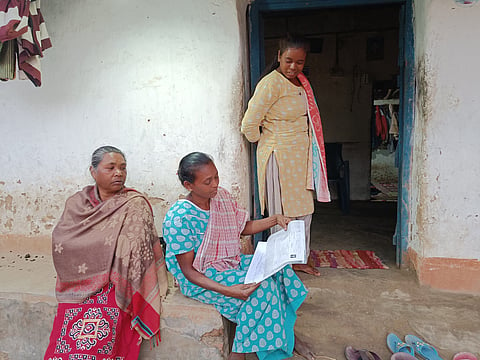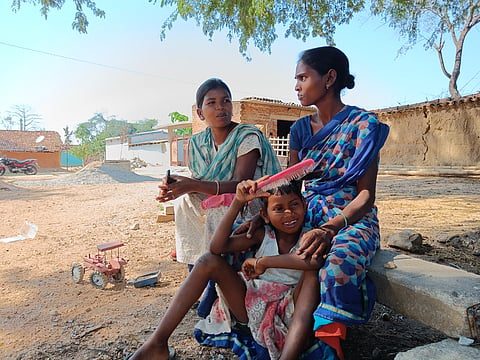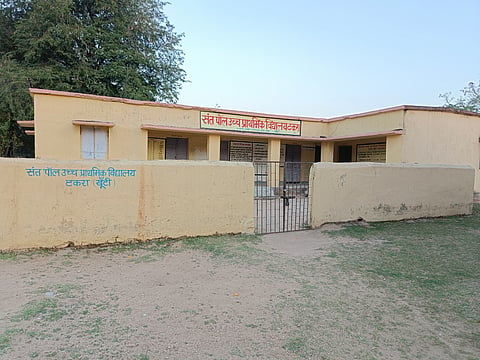"I wanted to join the police force. The people from the village and outside would tell me and my sister that we had the heights to make it," says Teresa Kachhap.
No High School, Housing: Tales Of Neglect From Jaipal Singh Munda's Village On His Death Anniversary
On the death anniversary of Jharkhand's Adivasi icon Jaipal Singh Munda, Outlook reaches his village to look at the lack of development and opportunities for the locals, even as crores of rupees have been spent on projects in his name.
"I wanted to get a B.Ed. and teach in the village school," says Srishti Silvanti Kachhap.
As Teresa and Srishti Silvanti tell us of these dreams from the past, they are climbing the stairs of an under-construction stadium with cement mortar on their heads. Their aspirations have been sacrificed at the altar of financial constraints. They have been forced to work as labourers to feed their families. At present, they earn a daily wage of Rs 300 in their village Takra.
Srishti Silvanti, 26 now, is troubled by questions like when and why; she no longer wants to talk about it. But after some persuasion, she agrees to speak with Outlook. She says, “I wanted to become a teacher and teach in the village school. I wanted to educate the village children and pull them out of illiteracy. I quit my studies due to financial difficulties, but I do not want other boys and girls of the village to have to do the same.”
Located in the Khunti district of Jharkhand, Takra is no ordinary village. It is the home of the great tribal leader, activist, intellectual, and thinker Jaipal Singh Munda. After completing his initial studies from his village, he went on to pursue higher education from the University of Oxford. But for Teresa and Srishti Silvanti, it is impossible to even go to Ranchi, which is only 25 kilometres from their village, for their further studies.
Srishti requests the Jharkhand government to open a quality high school in Takra in the name of Jaipal Singh Munda, where the poor children of the village can go to study.
Srishti was the first among four siblings to start studying for a B.A. She had not even completed a year at Ranchi’s Saint Paul College when her father, Philmohan Kachhap (52), passed away. The family could no longer manage to send eight thousand rupees every six months for Srishti's studies. As a result, she had to leave her studies. The family’s poor finances had already forced her brothers Anil Kachhap (28) and Akhil Kachhap (27) to stop studying after their intermediate and matriculation levels respectively. The eldest sister Leeli Kachhap (30) could not even do her matriculation.
Srishti says that their mother, Mariam Kachhap (50), used to manage the household and their father supported Srishti's education with his earnings from farming and daily wage labour. But he passed away during the second lockdown in 2021, and by 2022, Srishti had switched to working as a daily wage earner herself.
Teresa (22) had similar dreams, but economic circumstances forced her to work as a labourer. She tells Outlook, “I wanted to study and become a policewoman to help people. But how could I continue my studies? Even the school for classes 10 and 12 was seven kilometres away from the village. I would go there by bicycle and on foot. But how do you go to Ranchi daily for college? Where would I get the money to go to college? Father died six years ago. My elder brother did not earn anything at the time. Both my younger sister (Jacinta Kachhap, 18) and I had to quit our studies after class 12.”

Teresa has an elder brother who does tent work. The younger one is in class 8, but Teresa cannot say how and for how long he will be able to continue his studies.
Both Srishti and Teresa wish to resume their education, if only someone would help them.
There is a long list in the village of children and young adults who, driven by financial constraints, discontinued their education midway and began working as wage labourers. Among these are Philmohan Kachhap (27, class 10), Badhuram (21, class 5), James Kachhap (18, class 9), Sanjay Kachhap (20, class 10), Jacinta Kachhap (18, class 12), Sanjana Kachhap (23, class 12), Suraj Kachhap(18, class 8), Sandapi Kachhap (23, class 12), Sanju Kachhap (20, class 12), and Shanti Kachhap (28, class 12).
Takra is part of the Murhi panchayat in Khunti. With 18 villages, the panchayat has a population of around 15 thousand. While poverty is admittedly a huge hindrance to education, people here believe that the absence of even a single high school for catering to such a large population is also a reason for many of them not being able to study.
Former upamukhiya of the village Pyarchand Bhengra says, “The government has not paid us any attention. We have repeatedly demanded the MLA and the education officer to build a high school here. Written applications were also given, but with no results. At most, only 50 per cent children in the entire panchayat are able to do their matriculation. And if you look at the intermediate-level figures, it reduces to 30 per cent. And only 20 per cent of the children are able to go to college and become graduates.”
Takra’s current pradhan, John Kachhap (41), is a relative of Jaipal Singh Munda. Recalling the assurances given over the past ten years, he tells Outlook, “A fair is held here twice a year, on Munda’s birth anniversary (January 3) and death anniversary (March 20). Leaders and ministers descend here on those occasions. They say that they will do this and that. Yet, this remains the village of Jaipal Singh Munda in name only. He went abroad for his studies, and a hundred years later, not even a high school has not been built here. For the tenth standard, our children have to go to a school 10 kilometres away.”
Jaipal Singh Munda was the first tribal of India to study abroad. He read at the Oxford University, England, from 1922 to 1929. Inspired by his example, the Jharkhand government launched the Marang Gomke Jaipal Singh Munda Overseas Scholarship Scheme in December 2020. In the last four years, dozens of students have been sent abroad at the government’s expense, but when it comes to Munda’s own village, no one knows the quality and extent of the education that is accessible to the children.
Takra has been adopted by Union Minister and Khunti MP Arjun Munda under the Adarsh Gram Yojana. According to the top local administrators of the village, Arjun Munda is among those who promised to bring development to the villagers. He had promised a village library and a pucca house to every family. In the five years since these promises were made, nothing seems to have materialised on the ground.
Sixty-year-old Bahamuni Kachhap has been living in a collapsed mud house for the past several months. She tells Outlook, “We live in the open, even in the rain and cold. Where will we go? How long can we shelter at someone else's place? People cannot play host to us endlessly. All our belongings are lying out in the open, the bed, the dishes, everything. We have neither a house nor a ration card. I get no old age pension either. If he gets two hundred rupees in wages, we buy some ration and prepare a meal, otherwise we just go to bed hungry.”
Bahamuni says she applied to the village mukhiya for a house under the Pradhan Mantri Awas Yojana, only to be told that she had missed the deadline for filling the form. Saroj Topno (30) and her family have also been living in a collapsed house. She, too, says that she applied to the mukhiya for a residence. Sita Kachhap (35) is another villager without a PM residence and a ration card. She and her husband eke out a living by performing wage labour.
Referring to their problems, all three women note the irony of living in Jaipal Singh Munda's village without even the basic facilities. According to the village pradhan and mukhiya, so far, only about 30-40 of the 200 families in the village have benefited from the Pradhan Mantri Awas Yojana.

John Kachhap says that the benefits of Takra’s name value have accrued to many others, but not to the poor boys and girls of Takra. He adds, “Takra's children do well in studies, but their families’ plight stops them from studying further. The parents have no steady jobs. How would they send their children out for higher education? And if they sell the paddy to pay for their education, what will they eat? The least that the government can do is establish a high school and college here. And every year, it should sponsor 10 of our best students for an education in Ranchi.”
With a score of 92 in mathematics and 86 in science, Premchand Kachhap (25) secured 77 per cent marks in class 10 in 2014. He wanted to become an engineer, but he found no source of support. He tells Outlook, “That year, I was the top scorer in the entire panchayat. I enrolled in class 12, but could not pursue my studies further. The financial condition of the family was not good. My mother passed away in my childhood and my father died when I was in class 9. Grandmother raised me and my younger sister was with our aunt. There was no one in the house who was earning. We had a small piece of land, but I was not able to make any money from it. So I had to leave my studies and start working as a daily wager.”
Sahul Kachhap (23) narrates a similar story. He passed his board examinations in 2018 with 66 per cent marks, but like hundreds of boys and girls of the village, he too had to leave his studies and take up wage labour.
Khunti is a tribal-dominated district which has been affected by drought more than 10 times in the last 24 years. In years of good rainfall, people harvest paddy. When the rains are scant, they have no option but to go out and work as labourers. The villagers live hand to mouth. As such, MNREGA work, often paying too little too late, is not a good option for them. However, under the Village Tap Water Scheme, water has reached more or less every house. Moreover, a check dam and a hockey stadium have been built in the village. The villagers want a high school to be constructed next.
According to government figures, the district of Khunti, comprising six blocks, 86 panchayats, and 765 villages, has irrigation facilities for a mere 8.30 per cent of its cultivable land. In terms of educational infrastructure, it has about 750 primary, 190 middle and 45 high schools. There are six primary schools and a middle school in the Murhi panchayat. There are approximately 430 students in these schools, with 18-20 teachers. Two of the seven schools are run by missionaries.
The primary school in Takra, where Jaipal Singh Munda also received his primary schooling, is called Saint Paul Primary School. It is not a fully government-run school, but rather comes under the minority quota. The teachers report that, for this reason, the school never receives its annual painting stipend of Rs 5,000-6,000 on time. More than once, they have had to spend their own money to get the school painted.

Speaking on these problems, villager Badua Oraon tells Outlook, “The mukhiya has no authority. To whom do we apply? To whom do we report our issues? No one listens to us. The people sitting above us do not have the right attitude towards education. A school has been built but it is not managed well. It does not have boundary walls. teachers, a toilet, and water supply. When we complain to the education officer, he says he will get things done if we give him the money from our funds.”
Oraon is of the opinion that the government is actually closing down schools instead of opening them. Questions have always been raised regarding education in Jharkhand. Four thousand schools in the state have been merged. The number of school dropouts is also a challenge for the government. According to the Jharkhand Education Project’s 2020-21 survey, there are 6,21,703 children of 6-14 years in the state. Despite the government’s efforts, only 67,562 of them have been enrolled. The remaining 5,54,141 children have been deemed dropouts.
(Translated by Kaushika Draavid)